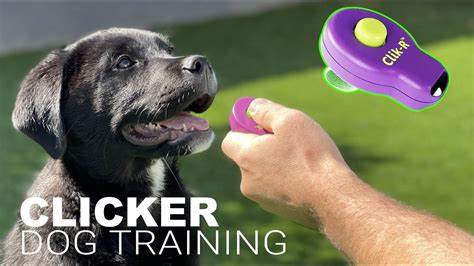Clicker Training: A Comprehensive Guide
Clicker training is a form of animal training that uses a device that produces a clicking sound to mark and reinforce desired behaviors. It is based on the principles of operant conditioning, which states that behaviors that are followed by positive consequences are more likely to be repeated, and behaviors that are followed by negative consequences are less likely to be repeated. In clicker training, the clicker acts as a secondary reinforcer, or a stimulus that acquires its reinforcing value through association with a primary reinforcer, such as food or praise. The clicker is used to bridge the gap between the behavior and the reward, making the animal aware of what behavior is being rewarded.
In this blog post, we’ll discuss the pros and cons of clicker training and help you decide if it’s the right approach for you and your dog.

What is clicker training and how does it work?
Clicker training is a form of positive reinforcement training, which means that you reward your dog for doing something you like, rather than punishing them for doing something you don’t like. Positive reinforcement training is based on the principles of operant conditioning, which states that behaviors that are followed by positive consequences are more likely to be repeated, and behaviors that are followed by negative consequences are less likely to be repeated.
In clicker training, the clicker acts as a secondary reinforcer, or a stimulus that acquires its reinforcing value through association with a primary reinforcer, such as food or praise. The clicker is used to bridge the gap between the behavior and the reward, making the dog aware of what behavior is being rewarded.
For example, if you want to teach your dog to sit, you would wait for your dog to sit on their own, or lure them into a sitting position with a treat, and then click and reward them. By doing this repeatedly, your dog will learn to associate the click with the reward, and the reward with the behavior. Eventually, your dog will sit whenever they hear the click, or whenever you give them a cue, such as a word or a hand signal.
What are the benefits of clicker training?
Clicker training has many advantages over other training methods, such as:
- It improves the communication between you and your dog, as the clicker provides a clear and consistent feedback that your dog can easily understand.
- It increases the motivation and interest of your dog to perform the behavior, as the clicker creates a positive and fun experience for your dog, and makes them eager to learn and earn the reward.
- It enhances the learning and retention of the behavior, as the clicker reinforces the behavior immediately and precisely, which strengthens the neural connections in your dog’s brain.
- It facilitates the shaping, chaining, and generalization of complex behaviors, as the clicker allows you to break down the behavior into smaller steps, and reward each step individually, rather than waiting for the final outcome. This way, you can teach your dog to do things that would otherwise be difficult or impossible to teach, such as fetching, rolling over, or playing dead.
- It reduces the use of aversive methods and increases the welfare of your dog, as the clicker focuses on rewarding the desired behavior, rather than correcting or punishing the undesired behavior. This way, you can avoid causing fear, stress, or aggression in your dog, and build a trusting and cooperative relationship with them.
- Clicker training fosters a positive and stress-free learning environment, promoting trust and cooperation between the trainer and the animal.
What are the drawbacks of clicker training?
Clicker training is not without its challenges, such as:
- It requires good timing, consistency, and fading, as the clicker needs to be used at the exact moment when the behavior occurs, and every time the behavior occurs, until the behavior is learned and reliable. Then, the clicker needs to be gradually faded out, and replaced by other forms of reinforcement, such as verbal praise, petting, or play. If the clicker is used too early, too late, too often, or too rarely, it can confuse or frustrate your dog, and weaken the effectiveness of the clicker.
- It can be influenced by individual differences, environmental factors, and ethical issues, as the clicker may not work equally well for every dog, every trainer, and every situation. For example, some dogs may be more sensitive or less responsive to the sound of the clicker, some trainers may have more or less skill or patience with the clicker, and some situations may be more or less suitable or safe for using the clicker. Moreover, some people may have ethical concerns about using a clicker, as it may be seen as a form of manipulation or coercion, rather than a form of communication or cooperation.
- Clicker training may require an initial investment in clicker devices and training resources or classes.
- Clicker training is not a magic bullet and may not address all behavioral issues. It should be combined with other training techniques and, if necessary, professional guidance
Why Clicker Training Is Bad: The Truth Behind the Click
Clicker training is a popular method of dog training that uses a device that makes a clicking sound to mark and reward desired behaviors. It is based on the principles of operant conditioning, which states that behaviors that are followed by positive consequences are more likely to be repeated, and behaviors that are followed by negative consequences are less likely to be repeated. In clicker training, the clicker acts as a secondary reinforcer, or a stimulus that acquires its reinforcing value through association with a primary reinforcer, such as food or praise. The clicker is used to bridge the gap between the behavior and the reward, making the dog aware of what behavior is being rewarded.
While clicker training may seem like a simple and effective way to teach your dog new skills, it also has many drawbacks and limitations that make it unsuitable for many situations.Here, we will explore the reasons why clicker training is bad, such as:
- It depends on external rewards, which can reduce the dog’s intrinsic motivation, create a dependency on the reward, and diminish the value of the reward over time.
- It lacks flexibility, which can make it difficult to adapt to different dogs, trainers, and contexts, and to correct unwanted behaviors and train alternative behaviors.
- It can create confusion and frustration, which can occur when the clicker is used incorrectly, inconsistently, or infrequently, or when the dog does not understand what is expected of them.
- It raises ethical concerns, which can arise from the use of a clicker as a form of manipulation or coercion, rather than a form of communication or cooperation.
- Misinterpretation of Clicks: Dogs may misinterpret clicks as commands or attention-seeking cues, leading to unwanted behaviors.
- Overemphasis on Treats: Overemphasis on treats can diminish the importance of non-food rewards, such as praise, affection, or playtime.
- Limited Versatility: Clicker training may not be as effective for addressing certain behavioral issues, such as aggression or reactivity.
Therefore, clicker training can undermine the dog’s natural drive and interest in learning and performing the behavior, and make them dependent on artificial stimuli. This can reduce the quality and durability of the behavior, and the dog’s well-being.
We will also provide some tips and alternatives on how to train your dog effectively and appropriately without using a clicker.
How to use a clicker effectively and appropriately?
To use a clicker effectively and appropriately, you need to follow some basic steps, such as:
- Choose a good clicker that suits your needs and preferences. There are different types and styles of clickers, such as box clickers, button clickers, ring clickers, or necklace clickers. Some clickers are louder, softer, bigger, or smaller than others. You need to find a clicker that is comfortable to hold and easy to use, and that produces a sound that is audible and pleasant for you and your dog.
- Charge the clicker by pairing it with a reward. Before you start using the clicker for training, you need to teach your dog what the clicker means. To do this, you need to click and reward your dog several times, without asking them to do anything. This way, your dog will learn to associate the click with the reward, and the reward with something positive. You can use any reward that your dog likes, such as food, toys, or attention, but make sure that the reward is small, tasty, and easy to deliver.
- Mark and reward the behavior that you want your dog to learn. Once your dog understands the meaning of the clicker, you can start using it to mark and reward the behavior that you want your dog to learn. You can either capture the behavior when your dog does it on their own, or lure the behavior with a treat or a toy. As soon as your dog performs the behavior, you need to click and reward them. You can also add a cue, such as a word or a hand signal, to label the behavior and ask your dog to do it on command.
- Repeat the process until the behavior is learned and reliable. You need to repeat the marking and rewarding of the behavior until your dog can do it consistently and confidently, with or without the cue. You can also vary the criteria, such as the duration, distance, or distraction, to make the behavior more challenging and realistic. You can also combine different behaviors to create a sequence or a routine, such as sit, down, and stay.
- Fade out the clicker and use other forms of reinforcement. Once your dog has learned the behavior, you need to gradually fade out the clicker, and use other forms of reinforcement, such as verbal praise, petting, or play. You can also use a variable reinforcement schedule, which means that you reward your dog randomly and unpredictably, rather than every time. This way, you can maintain the behavior without depending on the clicker, and keep your dog motivated and interested.
Alternative Training Methods of Clicker Training
There are several alternative training methods of clicker training that you can use to teach your dog new skills and behaviors. Some of the most common ones are:
- Dominance training: This method is based on the idea that dogs are pack animals that need a strong leader to follow and obey. The trainer uses physical and verbal cues to establish their authority and dominance over the dog, and corrects or punishes any unwanted behaviors. This method can be effective for some dogs that respond well to clear rules and boundaries, but it can also cause fear, stress, or aggression in others that may perceive the trainer as a threat or a rival.
- Positive reinforcement training: This method is based on the idea that dogs learn best by being rewarded for doing something right, rather than being punished for doing something wrong. The trainer uses treats, toys, praise, or play to reinforce the desired behaviors, and ignores or redirects the undesired behaviors. This method can be effective for most dogs that enjoy learning and earning rewards, but it can also cause overfeeding, spoiling, or dependency in others that may become too reliant on the rewards.
- Model-rival training: This method is based on the idea that dogs learn by observing and imitating other dogs or humans. The trainer uses another dog or a person as a model or a rival to demonstrate the desired behaviors, and rewards or scolds them accordingly. The dog watching then tries to copy the model or compete with the rival to earn the same rewards or avoid the same scolds. This method can be effective for some dogs that are social and curious, but it can also cause confusion or frustration in others that may not understand what is expected of them.
- Relationship-based training: This method is based on the idea that dogs learn by building a trusting and respectful relationship with their trainer. The trainer uses empathy, communication, and cooperation to understand the dog’s needs, personality, and emotions, and to teach the dog the desired behaviors. The trainer also adapts the training to the dog’s individual abilities, preferences, and pace. This method can be effective for most dogs that seek a bond and a partnership with their trainer, but it can also require more time and patience than other methods.
- Lure-reward training:This method uses a lure, such as a treat or toy, to guide the dog into the desired position or behavior.
- Capture training:This method involves rewarding the dog for spontaneously performing the desired behavior.
- Shape training:This method involves breaking down a complex behavior into smaller, more manageable steps.
- Traditional Obedience Training:This method combines verbal commands, praise, and corrections to instill basic obedience skills.
These are some of the best alternatives to clicker training that you can use to train your dog effectively and appropriately. You can choose the method that suits your dog’s temperament, learning style, and goals, or you can combine different methods to achieve the best results.
FAQS
When to Stop Clicker Training?
Clicker training is typically used in the initial stages of training to establish a clear connection between the desired behavior and the rewarding click. As the behavior becomes more established, the frequency of clicks can be gradually reduced, eventually phasing out the clicker entirely.
Is a Clicker Bad for a Dog?
Clicker training, when used correctly, is not harmful to dogs. However, it’s important to acknowledge the potential drawbacks mentioned above. When considering clicker training, it’s crucial to assess your dog’s personality, motivation level, and learning style to determine if it’s the most suitable approach.
Should You Train a Dog with a Clicker?
Whether or not you should train your dog with a clicker is a personal decision. If you are patient, consistent, and have the time to dedicate to training, then clicker training can be a great option. However, if you are looking for a quick and easy training method, or if your dog is not motivated by food or treats, then clicker training may not be the right choice for you.
Why Clicker Training is Bad for Puppies
Clicker training is not inherently harmful to puppies. However, it’s crucial to adapt the training approach to their developmental stage. Puppies have shorter attention spans and require shorter training sessions with frequent breaks.
Is clicker training suitable for all dog breeds?
Clicker training can be adapted for various breeds, but its effectiveness may vary. Some dogs may respond better to different training methods.
Can clicker training be used for addressing aggression in dogs?
Clicker training alone may not be sufficient for addressing aggression. Consultation with a professional trainer is advisable for such behavioral issues.
Conclusion
Clicker training is a simple and fun way to train your dog, using a device that makes a clicking sound to mark and reinforce desired behaviors. Clicker training can improve the communication, motivation, and learning of your dog, and facilitate the shaping, chaining, and generalization of complex behaviors. Clicker training can also reduce the use of aversive methods and increase the welfare of your dog. However, clicker training also requires good timing, consistency, and fading, and can be influenced by individual differences, environmental factors, and ethical issues. To use a clicker effectively and appropriately, you need to choose a good clicker, charge the clicker, mark and reward the behavior, repeat the process, and fade out the clicker.
Related Posts
Are Dogs Allowed In CVS?
March 22, 2024• Dog
Are Dogs Allowed in Duane Reade?
March 22, 2024• Dog
Natural Dewormers for Dogs: Safe and Effective
March 15, 2024• Dog, Dog Health
How Do I Comfort My Dog After Neutering?
March 6, 2024• Dog, Dog Health
Dog Rubs Face on Carpet: A Guide to Why
March 5, 2024• Dog













